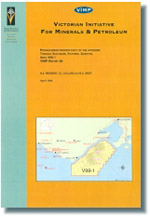VIMP Report 60 - Hydrocarbon prospectivity of the offshore Torquay Sub-basin, Victoria: Gazettal Area V99-1
 |
| |||||
Product description:Download The downloadable version of this report is supplied in PDF format. Executive Summary Invitations to explore for hydrocarbons, under the work program bidding system, in Area V99-1 of the eastern Otway Basin have been gazetted in April 1999. V99-1 is a large (7,200 km˛), under-explored, shallow water area comprising virtually all of the offshore Torquay Sub-basin. Applications for the acreage close on 14 October 1999. This re-evaluation of the hydrocarbon potential, carried out by Minerals and Petroleum Victoria, shows that there is likely to be significant untested potential in the Sub-basin. The offshore part of the Sub-basin has two main structural elements, namely the Snail Terrace and the Basin Deep, the latter bounded to the northwest by the onshore Otway Ranges and flanked to the southeast by the shallower Snail Terrace. The region has a tectonic history that reflects two basins. The Late Jurassic to Early Cretaceous rift sequence is similar to the western Otway Basin, whereas the Late Cretaceous to Recent sequence is more akin to the Bass Basin. Three wells have so far been drilled in the Sub-basin: Nerita 1 (1967), Snail 1 (1972) and Wild Dog 1 (1992), all of which targeted the Tertiary section and were dry. Nerita 1 can be shown to be a late compressional feature which post-dated expulsion and migration of hydrocarbons. There is no closure at Snail 1 and Wild Dog 1 is a relatively late compressional feature, which is partly fault dependent but appears to be a valid trap. The cause of failure, although not clearly understood, may be due to the structure post-dating the main migration phase, the presence of thief zones within the cross-fault seal, or charge unable to reach the structure. Significant gas shows were encountered in Nerita 1 in both the Late Cretaceous – Early Tertiary Eastern View Group and the Early Cretaceous Eumeralla Formation. The Eastern View Group shows are related to coals but the deeper gas shows within the Eumeralla suggest an active petroleum system may be present in the Sub-basin. In addition, sea-bed gas anomalies have been detected by BMR (now Geoscience Australia) north of Nerita 1 in areas where pockmarks are evident on the sea-bed. There are potentially two petroleum systems working in the Torquay Sub-basin. The Crayfish Sub-group petroleum system is sourced by claystones of the Casterton and Pretty Hill Formations and is likely to work mainly in the vicinity of the Snail Terrace. The Eumeralla petroleum system is sourced by coals in the basal section of the Eumeralla Formation and is more closely aligned with the Basin Deep. With only limited data available on palaeotemperature gradients, there is significant scope for variations in heat-flow and therefore the timing of hydrocarbon expulsion. The presence of gas fields further west in the basin show the claystones of the Pretty Hill Formation and Eumeralla Formation to be effective seals. Geochemical analysis of the Early Cretaceous Eumeralla, Pretty Hill and Casterton Formations throughout the Otway Basin demonstrate that they contain source rocks capable of generating both oil and gas. Thicknesses of the Early Cretaceous are more than adequate for thermal maturity. By analogy with the Otway Basin further west, where there is significant gas in the onshore Port Campbell Embayment and offshore at Minerva and La Bella, gas is the most likely hydrocarbon type. However, on the Snail Terrace, the chance of encountering oil is higher because part of the source interval is still probably within the oil window. The principal remaining play types in the Torquay Sub-basin are tilted fault block traps within the Early Cretaceous, and it is these play-types, which are successful elsewhere in the basin, that are proposed for the next phase of drilling. One of the major targets in the western part of the Otway Basin is the Pretty Hill Formation, which is thought to be present at depths of around 2000 m on the Snail Terrace. Permeabilities of up 1000 md are present in these producing sandstones in the Katnook and surrounding gas fields in South Australia, at depths of 2500-3000 m. In the past, structural risk has been perceived as a major risk, but with additional infill seismic and state-of-the-art processing, this risk can be expected to be significantly reduced. MPV has carried out regional mapping in the area at Top Basement, Top Otway Group and Top Boonah Formation (Late Eocene sandstone). A number of leads have been mapped using the Top Basement Horizon as a guide. These include a very large structure in the Early Cretaceous beneath Wild Dog 1. Other play types, in addition to tilted fault blocks, are:
Bibliographic reference Messent, B.E., Collins, G.I. & West, B.G., 1999. Hydrocarbon prospectivity of the offshore Torquay Sub-basin, Victoria: Gazettal Area V99-1. Victorian Initiative for Minerals and Petroleum Report 60. Department of Natural Resources and Environment. | ||||||

